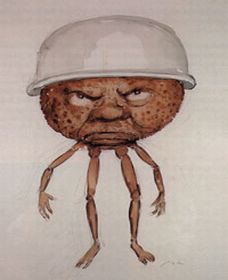
‘Sing a song of sixpence, a pocket full of rye, Four and twenty blackbirds baked in a pie…‘ ~ traditional nursery rhyme
Back in the fourteenth century, long before fridges and freezers came into existence, there was pie. Pie crusts were designed as a way of preserving food: a thick, hard, inedible casing called a coffyn made from flour, water and eggs. Inedible it may have been, but apparently it could keep the contents reasonably fresh for several days. The ‘medieval equivalent of canning,’ surmises Charles Perry of the Los Angeles Times. It has been suggested that the name ‘pie’ came from the Middle English word for magpie, a bird renowned for collecting all sorts of odds and ends in its nest. Similarly, the pastry ‘nest’ was often filled with an astonishing mixture of meats: from venison and wild boar to heron, duck and stork, to blackbird and crow.
Blackbirds may no longer be a fashionable filling among the connoisseurs of pies, desirable today only in nursery rhymes, but pies with alternate tasty innards remain hugely popular as a dinner, a dessert or a quick snack.
The Cornish pasty, a distant cousin to the traditional meat pie, was originally designed as a portable lunch for the tin miners to take to work. Their wives would wrap meat and vegetables in a pie crust, adding a thick handle of pie crust so the miners could throw away that part without making themselves sick from the arsenic-laden dust that covered their hands. The pasty has since accompanied Cornish miners all over the world, although these days, a lighter, flakier pastry means the handle remains as a decorative but edible feature.

Americans have claimed the sweet pie: pumpkin, apple, peach, key lime, banoffee. The list is endless. In Australia, we have made the meat pie our own. The recipe for pie was brought to the colonies by the British, of course. By 1850, the pieman was already ‘a conspicuous institution’ in Sydney (from Michael Symons book ‘One Continuous Picnic’). Less than a century later, and presumably tongue-in-cheek, meat pie with tomato sauce was being touted as our national dish. And by the 1970s, meat pies had become a lunchtime staple: in school canteens; in corner delis; for football fans as the Aussie equivalent of American hot dogs (Michael Symons again).
The Pie Floater is still remembered fondly in Adelaide. Once popular with late night revellers, the pie cart would wait resolutely in Victoria Square for peckish passers-by. This extraordinary dish consists of a meat pie turned upside down in a bowl of mushy pea soup, and squirted with tomato sauce.
The South Australian National Trust recognized the pie floater as a South Australian Heritage Icon in 2003, although sadly, the last pie cart was forced to close four years later. About that same time, I was treated to a delicious, and decidedly more sophisticated version at the Adelaide Hilton, courtesy of TV chef Simon Bryant, who kindly presented his recipe on an episode of The Cook and the Chef, so we could all add it to our kitchen repertoire.
Since we moved back to Adelaide last year, our feet have all too often found their way to the nearest bakery in search of sausage rolls, pasties, meat pies or an apricot pie with ice cream for later. The steak and pepper pie has become a firm favourite, although I fear it is adding generous inches to my waistline. Therefore, it’s probably a blessing that I’ve always had a morbid fear of making pastry. Many years ago, my first weekend job was stuffing pasties at Opie’s Bakery, but I never learned the skill of creating perfect pastry. The list of ingredients may be minimalist, and the method looks simple enough, thus I am bound to find it excruciatingly difficult! Anyway, why should I tie myself in knots trying to achieve something that will bear only a tragically distant resemblance to the glorious pies that Simon Bryant – and every local baker – creates with effortless ease? I accept my limitations, despite exhortations from Martha Stewart who produced an entire cookbook on pies and tarts. At least Julia Childs understands the fear of disaster – soggy dough, crumbly dough, too hard, too flaky – and cheerfully provides much helpful advice on how to avoid failure, for those of you brave enough to follow her lead. Her best tip is always to keep a marble rolling board in the fridge, as temperature plays a crucial part in creating an edible, visually satisfying pastry.
All this talk of pies reminds me of that wondrous children’s book The Magic Pudding, which the author himself describes as ‘that little bundle of piffle,’ written to win a bet that children prefer stories about food and fighting to magic and fairies. And yet, as the title suggests, that cut-and-come-again pudding was as magical as it was edible!

“The Magic Pudding is a pie, except when it’s something else, like a steak, or a jam donut, or an apple dumpling, or whatever its owner wants it to be. And it never runs out. No matter how many slices you cut, there’s always something left over. It’s magic. But the Magic Pudding is also alive. It walks and it talks, and it’s got a personality like no other. A meaner, sulkier, snider, snarlinger Pudding you’ve never met.’ ~ Norman Lindsay
I never understood why Albert (the name of the magic pudding) was so grumpy, but the idea of a constantly available snack is making me hungry. So, on that note, I’m off to the bakery for a steak and pepper pie. With sauce. Of course!
*With thanks to Google Images for the pics.

Thanks for another lovely escape for 10 minutes Ali ⭐️
Thanks Holly xx
Thanks again Ally. Your words bring you all closer. I think that your Mum gave N & D the Magic Pudding when they were little. Happy Memories and love to all.
xxxBetty xxx
hugs xx